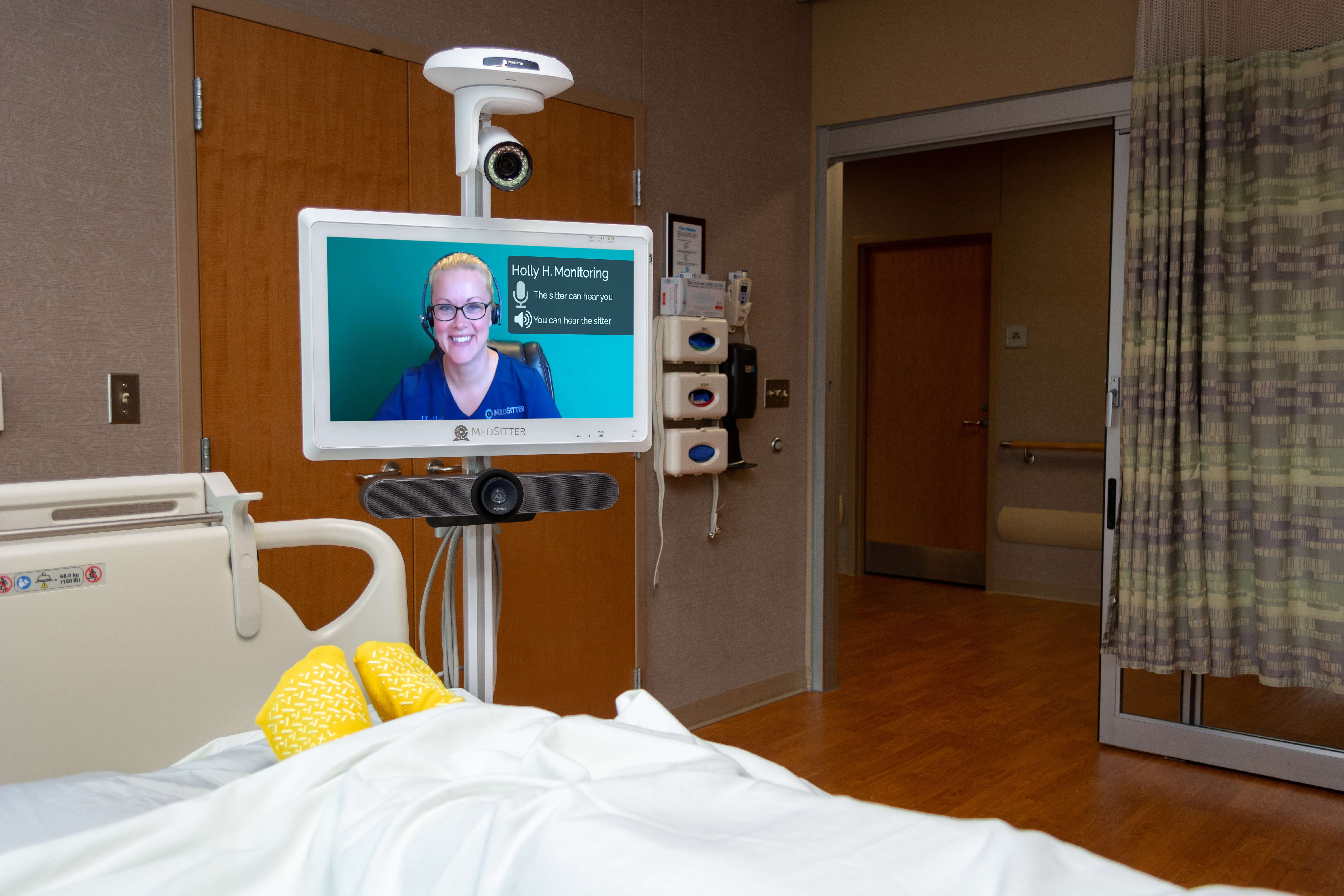Patient sitters are used to prevent adverse events for at-risk patients. With MedSitter, one patient observer can watch up to ten patients at one time, keeping more patients safe without straining staff resources. With persistent video, the connection between the remote observer and the patients under their care is always on, so communication in instant.
MedSitter is a remote patient observation tool that improves patient safety and satisfaction. With MedSitter, one observer can watch up to ten patients at one time. A cart is placed in a patient’s room, and a 360 degree camera streams a live feed to a remote sitter station. Motion detection technology alerts the sitter to in-room activity, and through a persistent video connection, the sitter can instantaneously communicate with the patient they are observing.
Why Video Observation?
When a patient is in the hospital, it is the hospital’s responsibility to keep them safe. That being said, the nurse-to-patient ratio is almost never 1:1. This means that nurses will be in and out of patient rooms, and for a decent amount of time a patient will be left alone. If a patient requires dedicated attention (for example, if they are at risk of falling), a 1:1 sitter may be assigned to physically sit in the patient's room with them. This is an effective solution, but in most cases hospitals simply cannot spare enough staff to sit 1:1 with every patient who may need it. Nurses are left in the difficult position of triaging risk levels and leaving some patients vulnerable. This already difficult situation has been made even worse by the ongoing nursing shortage. (Source: University of St. Augustine).
MedSitter makes sitters more accessible by leveraging remote video technology to connect one sitter with up to ten patients at one time. With MedSitter, one observer is 10x more efficient and less patients are left alone. In fact, the MedSitter logo is an angelfish specifically because angelfish are never found alone in nature. MedSitter takes video patient observation a step further by maintaining a persistent video connection between the remote observer and their patients.
Persistent Video - Explained
The term “persistent video” refers to an unbroken video connection between the sitter and the patient. This means that a while a patient is under MedSitter observation, a video connection between the patient and the sitter is always on. The sitter sees the patient at all times, but the patient only sees the sitter when the sitter opts to disable the privacy screen. When the privacy screen is enabled, the observer’s image is blurred and their microphone is muted. This way, the observer can remain connected to the patient without disturbing them. It is an unobtrusive way to keep a connection intact. When the observer needs to communicate with the patient, they simply disable the privacy screen with one click and are instantly visible to the patient.
Why Persistent Video is Important
Patient observers are there to help prevent adverse events, like patient falls. Patient falls are a significant issue within hospitals. Elderly patients, sick patients, and patients coming off of anesthesia or on unfamiliar prescription drugs can all experience balance issues. These balance issues can lead to falls and falls can lead to serious injury. Despite the fact that falls with serious injury are considered never events by the Centers for Medicare and Medicaid services, studies have found that 3-5 inpatient falls occur for every 1000 bed days. (Source: AHRQ).
Patient falls can happen very quickly. A patient may decide they need to use the restroom, try to get up, pull out their IV and fall all within a matter of seconds. When situations like this arise, the remote observer simply has to unmute their microphone with one click, and they will be on screen in the patient's room. The observer can then speak to the patient, attempt to redirect them, and call on-floor nursing staff if the patient needs assistance. In extreme cases, the remote observer can sound an alarm so that floor staff knows they need to intervene quickly.
Without persistent video, a remote observer would have to place a video call to the in-room cart. This wastes precious time as the call is placed, a connection is established, and the observer appears on screen. Without persistent video, there is a window of time in which a patient can significantly hurt themselves, even under the watch of a remote observer.
Observers on the MedSitter platform are able to submit “Good Catch” reports when a fall or other adverse event is avoided. The following are all real reports submitted by MedSitter observers:
“Patient was at a high fall risk. She got up three times and leaned so far forward that a fall was likely. I was able to successfully redirect her each time.”
“I was able to talk an escape artist patient into coming back into her room.”
“An upset patient at a high fall risk attempted to get out of bed. The patient was upset because they wanted to lay down but were unsure about how to go about it. I talked the patient through the steps of safely lying down, and the patient was able to take a nap.”
“I reminded a patient not to pull on her IV.”
Without persistent video, patient intervention may not have been quick enough to prevent an adverse outcome.
If you are interested in installing MedSitter’s persistent video solution in your facility, Contact Us today.

